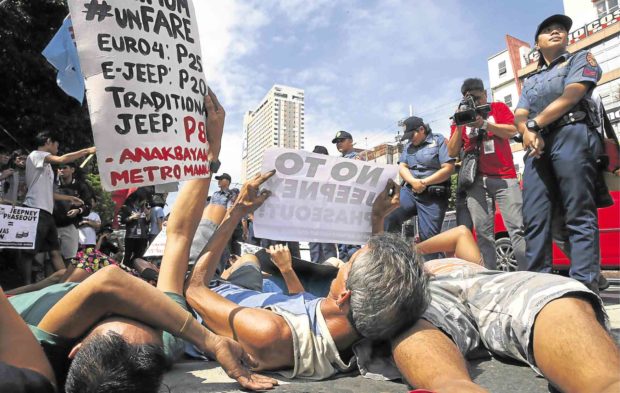
DIE-IN Jeepney drivers and their supporters stage a die-in along a busy Manila road to signal the start of a two-day nationwide strike to protest the government’s phaseout of old jeepneys. —BULLIT MARQUEZ / AP
A group of jeepney drivers and operators declared its strike on Monday a success, claiming it crippled by noon 90 percent of jeepney transportation in key urban centers.
But a government agency said the mass action was barely felt in most parts of the country.
A call, supported by Transportation Secretary Arthur Tugade, to charge Pinagkaisang Samahan ng mga Tsuper at Opereytor Nationwide (Piston) with economic sabotage suggested that the strike had somehow hurt the economy.
“They [are] selfish and small-minded. We want the Filipino public to be safe and have a better transport system,” Tugade said in a text message to Vivian Locsin of the Philippine Stock Exchange (PSE), who recommended that Piston “be charged [with] economic sabotage.”
Piston and allied groups are protesting the government program to phase out public utility vehicles (PUVs), including jeepneys, at least 15 years old.
The strike was the third to be spearheaded by Piston and the sixth to be staged by those opposing the PUV modernization program.
Work at all branches of government and on the PSE and classes in schools at all levels were suspended on Monday.
Classes resume
Malacañang said work in the government and classes would resume on Tuesday, the second day of the Piston-led transport strike.
Piston chair George San Mateo said that as of 9 a.m. the mass action had paralyzed 80 to 100 percent of transport routes in various parts in Manila, Makati, Caloocan, Malabon, Navotas, Quezon City and Marikina, and in Rizal province and other areas.
By noon, San Mateo said about 90 percent of jeepney transportation nationwide had been paralyzed. “Our strike is successful,” the Piston leader said at a rally on Aurora Boulevard in Cubao, Quezon City.
The Land Transportation Franchising and Regulatory Board (LTFRB) contradicted San Mateo’s claims, saying the strike was barely felt in most parts of the country.
An LTFRB board member, Aileen Lizada, said the agency received reports that jeepney drivers and operators who did not join the strike were forced not to ply their routes. “They should spare those who don’t want to join [the strike],” she said.
Tricycles had a field day ferrying passengers in many areas in Metro Manila where jeepneys stopped plying their routes.
Most LTFRB regional offices reported no disruption in transport services.
In Pampanga province, around 98 percent of public transport was paralyzed, a Piston leader said.
Allan Bonifacio, Piston coordinator in Central Luzon, said the strike was peaceful and successful in the province, except in Angeles City where a transport group did not join the mass action.
Few passengers were stranded as local governments fielded barangay service vehicles or buses.
In Bulacan province, the strike affected all major routes, Roman Polintan, Central Luzon chair of Bagong Alyansang Makabayan, said, adding that even jeepney drivers serving secondary routes joined the strike.
Supt. Marlon Santos, Bulacan police director, disputed Polintan’s claim, saying jeepneys did not stop ferrying commuters in different towns.
Southern Tagalog
Piston claimed paralyzing 98 percent of public transport in Southern Tagalog.
Rafael Arante, Piston regional spokesperson, said the strike was felt particularly at San Pablo City in Laguna province and affected the routes between Calamba City, also in Laguna, and Tanauan City and Lipa City, both in Batangas province.
The Laguna provincial government said the strike affected areas of Cabuyao City and the towns of Calauan and Victoria where there was “totally no jeepney [running]” on Monday morning.
In Quezon, police said no driver joined the strike in the province.
The police did not report any transport strike in the Bicol region and in the Mindoro provinces.
Visayas
In Cebu and Tacloban cities, the strike failed to cripple public transportation, as only a few jeepney drivers joined the strike.
Only 30 percent of the 1,000 members of Piston in Tacloban did not ply their routes.
Only about 150 Piston members joined the rally at P. Del Rosario and Osmeña Boulevard in Cebu City on Monday morning.
“The remaining 80 percent were plying [their routes] during that time,” said Cebu City Transportation Office operations chief Francisco Ouano.
Public transport remained normal on Panay Island, as transport groups did not join the strike.
Transport organizations led by Piston held a caravan to show support for the strike. The caravan, joined by 30 vehicles, assembled at a terminal in Iloilo City before proceeding to Mandurriao and Jaro districts.
Mindanao
In Cagayan de Oro City, about 90 percent of the public transport joined the strike, according to Ringo Lago, Starex-Piston secretary general.
Chief Insp. Mardy Hortillosa, however, said about 75 percent of public transport was paralyzed.
In Davao City, militant transport groups claimed crippling 90 percent of public land transport.
Carl Anthony Olalo, secretary general of Kilusang Mayo Uno in Southern Mindanao, said the strike succeeded in keeping most PUVs, particularly jeepneys, off the streets of Davao City.
The city government deployed 36 buses to seven areas to ferry stranded commuters. —REPORTS FROM PATHRICIA ANN V. ROXAS, JOVIC YEE, KRIXIA SUBINGSUBING, VINCE NONATO, DEXTER CABALZA, TONETTE OREJAS, CARMELA REYES-ESTROPE, MARICAR CINCO, DELFIN MALLARI JR., MAR ARGUELLES, MADONNA VIROLA, JOEY A. GABIETA, NESTOR P. BURGOS JR., NESTLE SEMILLA, JIGGER J. JERUSALEM AND FRINSTON LIM
RELATED VIDEO